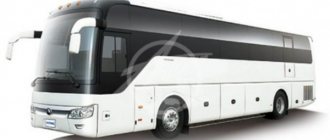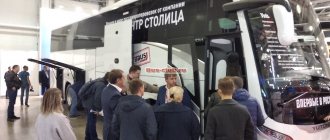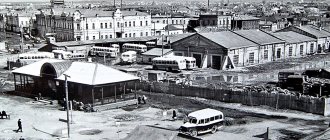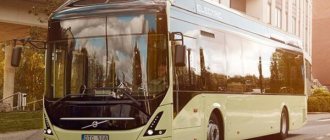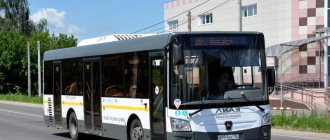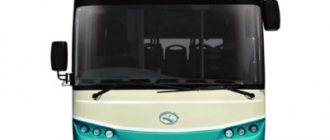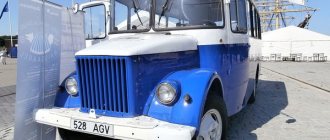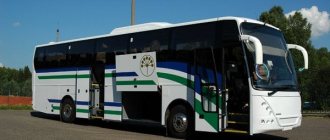Bus Van Hool ExquiCity 24. Photo Wikipedia
The leading company in the Belgian bus manufacturing market is Van Hool. An enterprise with a rich history has been effectively creating the future of global bus construction for decades. The use of technical solutions that were non-standard for its time, the bright distinctive parameters of the models, the talent of managers and employees - these are the main components of the success of the enterprise . This article is dedicated to the Van Hool company and the analysis of popular models.
About the manufacturer: logo and more
The Belgian engineering company was founded in 1947, is located in the Koningshoikt area of the town of Lier (in some sources the spelling “Lier” is found), specializes in the production of buses, trolleybuses and semi-trailers. The company manufactured its first bus body in 1947.
In the second half of the 50s, the company began cooperation with Fiat VC . buses on Leyland and Fiat chassis began . In 1964, the first Van Hool bus plant was launched, which continues to operate successfully today. Then a large production complex with an area of 46 hectares grew up near Antwerp.
Van Hool company logo. Photo Wikipedia
In 1971, Van Hool Espana, SA was founded in Zaragoza. In the 80s, the company gained even greater fame by starting to produce equipment on the Scania chassis . Later, Mercedes chassis were used as a base, now MAN. In 1981, the partnership with Fiat ended. In 1983, Van Hool Espana, SA was sold, then the plant was transformed into Hispano Carrocera, SAL
In the 80s, the company blew up the bus world by releasing the first city bus with a record low floor position relative to the road surface. In the following years, the company worked (and I must say successfully) to create a new modular concept of load-bearing bodies . In 1990, Van Hool acquired the LAG Bus plant (Belgium), then it was renamed EOS Coach Manufacturing Company , from whose assembly lines the EOS 80, 90, 90L, 100, 200, 200L, 233 models rolled off. In 2003, the production of EOS cars was discontinued, the plant was repurposed to produce Van Hool CL and TL series.
The company logo had several options; now the emblem is the spelling of the company name, made in white, on a blue or black background.
Model range: Altano, Alicron and others
Van Hool produces an extensive range of buses. The company revolutionized the production of models intended for the city, creating a car with a monocoque body of modular design . Distinctive features are giant trunks and a low floor height from the road.
City bus Van Hool A500. Photo Wikipedia
The manufacturer was the first to understand that the main problem of all buses is entry and exit, and tried to make it as convenient as possible for passengers. Every effort was made to reduce this parameter. During the development, the first Van Hool A500 city buses were released. It was on the Van Hool A500 bus that the gap from the floor above the road was only 500 mm, while the door width was 1300 mm. A little later, the company broke its own record and released models with a floor distance above the road of only 300 mm. Thus, you can freely enter these buses without actually raising your legs and easily enter in a wheelchair.
In addition to unique low-floor buses, the company also produces tourist and intercity buses , which stand out for their passenger capacity, comfort, safety and attractive appearance. As for the design, they are not distinguished by smooth body lines and are as close as possible to a cubic shape.
The lineup includes the following popular lines of equipment:
- Acron; produced since 1997, received the “Bus of the Year 1998” award, stands out for its comfort and sound insulation in the cabin;
- Alicron ; successor and actual copy of Acron, produced since 2000;
- Altano; a premium double-decker bus, produced since 2001, boasts a huge luggage compartment and soundproofed interior;
- Astromega; due to the absence of a second staircase, more passengers will enter the second floor.
A5 series buses
The representative of the A500 series is an ultra-low-bed bus with 100 seats, designed for the city with a weight of 18.1 tons and a floor to ground distance of 500 mm.
A model was produced with an overall height of 2880 mm and a wheelbase of 5500 mm (5670 mm). To this day, the design principles of the A 500 are used to produce the A 507 and A 508 buses, which are compact in size, as well as the A600 for commuter travel, designed for 87 seats and a power of 257 horsepower.
Features: device inside, is there a toilet and more
Features of the internal structure of buses depend on the purpose of the model . City cars are the standard of modern public transport, which combines high quality, reliability and ease of use. Intercity and tourist models are distinguished by a high level of comfort , as they are equipped with everything necessary for long-distance travel: air conditioning, audio and video systems, dry closet, refrigerator, coffee maker. It is also possible to note characteristics common to all models.
Van Hool vehicles are very comfortable buses with a spacious interior, which are distinguished by a competent and convenient layout, ergonomic driver's cabin and passenger compartment, modern interior and body design. Features of individual models are presented below.
Hydrogen fuel cell buses
Together with the American companies UTC Power and ISE Corp, Van Hool is working on the development of hybrid buses powered by hydrogen fuel cells.
The new products have already been tested in Belgium, the USA and Italy. The buses are equipped with fuel cells with a power of 120 kW UTC Power, high-temperature batteries, and Siemens electric motors. The maximum speed of the new buses is 104 kilometers per hour, and refueling lasts for 400-480 kilometers.
See the catalog of our models and order a bus with a driver at the Allegro shopping center.
Popular models
Van Hool is one of the few manufacturers in Europe that simultaneously assembles buses of its own integral design and builds bodies on chassis from other manufacturers - Volvo, Scania, Mercedes-Benz, MAN. Such flexibility of the model range allowed the company to conquer quite specific markets; for example, customers from Scandinavia, where many Belgian-made buses were delivered in the 80s and 90s, exclusively preferred cars on Volvo and Scania chassis. The models presented below are placed in accordance with the degree of interest in them from Internet users.
T8 Series
Van Hool TD824 Astromega bus. Photo Wikipedia
The T8 platform was introduced in 1979. The body has been developed based on the Alizee design launched last year. Over the course of several years, a number of tour buses were developed , each distinguished by a number and name following a clear naming convention. For example, in "TD824 Astromega":
- T = Touringcar (tourist)
- D = Dubbeldek (two-story)
- 8 = Part of the T8 series
- 24 = theoretical maximum number of rows of seats
- Astromega = model name
In 1991, an updated "T8 New Look" was introduced, called the T9 in its North American version. Production ceased in the late 1990s, following the introduction of the new (European) T9 platform.
Van Hool 815
The T815 was first introduced to the United States market in 1987. Subsequent models are known as the T8 series. The earliest models were equipped with Cummins L10 diesel engines : 10-liter, six-cylinder, in-line units. Later versions use Cummins M11 diesel engines : 10.6-liter, six-cylinder, in-line units that are characterized by economy, reliability and performance. The bus was available in 9.1, 12.2 and 13.7 m lengths.
T815: technical specifications and more
T815 is a modern, comfortable luxury bus , created specifically for tourist and intercity travel. This is a large, one-and-a-half-decker bus, equipped in such a way as to satisfy all the needs of the client.
The spacious interior and wide passage between the boarding seats allow passengers to feel comfortable, even if the trip is long. The “liner” has 49 passenger seats, equipped with soft, orthopedic seats with an adjustable armrest, a reclining backrest and the ability to move them to the side, which undoubtedly makes you feel like you’re in a home chair. Above the passenger seats there is an air conditioning and lighting system.
There are also two monitors in the cabin, for the convenience of passengers, they are located at the beginning and in the middle of the car, the sound from the monitors is supplied using an excellent stereo sound system.
Panoramic windows will not let you miss the chance to see the sights of cities, busy streets or picturesque places of nature.
On the ground floor there is a spacious luggage compartment, which can easily accommodate transported items.
Video
T815 Acron
T815 Acron is a two-axle tourist bus with an integrated Van Hool chassis, 4x2 wheel arrangement, capacity 53+2, manual transmission, MAN engine.
T9 Series
The new T9 series was launched in Europe in 1995. It included a completely new body design and many other changes. Later T9 series models feature front disc brakes instead of drum brakes. According to the identification number (VIN), T8 and T9 are considered one family.
The same philosophy was applied as with the T8: one platform, many different versions. Over the years, many new variants have been developed. Various models including Atlino and Atlon with different floor heights, Alicron, Acron and Astron , standard tourist buses with different heights and therefore luggage compartment of unequal volume, Altano with a driver's cabin located under the second floor floor, Astronef with a sloping floor in theatrical style and the Astromega .
In addition, the T9 body style is also available on chassis from Scania, Volvo and VDL, but only in Sweden and the British Isles. These buses are called Alizee (single-decker) and Astrobel (double-decker).
Important! The European T9 series should not be confused with the US market T9 series, which corresponds to the European T8 New Look.
The base model of the T9 family is considered to be the 12-meter tourist T915 Acron with an overall width of 2550 mm. and high location of the cabin. It is offered with a rear-mounted MAN diesel engine with a power of 310-380 hp, a manual 6-speed ZF gearbox, air suspension, front disc brakes and independent suspension.
Van Hool Astromega TD927 bus. Photo Wikipedia
The cabin for 36-53 seats is equipped with an automatic climate control system, leather seats, natural wood trim, and liquid crystal displays through which the passenger can monitor the route.
New for 2000 was a simplified 310-horsepower version of the T915CL for local traffic with a capacity of 53-55 passengers with an overall height of 3210 mm and a floor height of 860 mm. and trunks with a capacity of 4.1 m3.
The intercity 55-seat version of the T915TL has an overall height of 3340 mm and a floor height of 1150 mm.
The development of the basic model became the top-class tourist buses T917 Acron and T918 Altano (6×2) with a length of 13.7 m with an elevated and high cabin arrangement for 40-55 people. The power of the rear vertical engine is 380-420 hp. With.
The new range is completed by the 3-axle, 2-story bus TD927 Astromega (6x2) with a capacity of up to 74 people, although usually 25-30 passengers are located on the second floor, and the first level is reserved for the trunk and utility rooms.
Van Hool T917 Acron: numbering and more
The T917 Acron tourist bus with a capacity of 61+1+1 is equipped with a six-cylinder turbocharged diesel engine MAN D2676 LOH27 with a volume of 12.412 liters and a power of 480 hp, which complies with the Euro 5 standard, and a Mercedes MB GO230 gearbox. The technically permissible weight is 24400 kg.
Equipment: air conditioning, climate control, additional Webasto heating system, TV, audio system, DVD, TV, microphone, numbered seats, toilet, as well as a kitchen: coffee maker, boiler, refrigerator, food compartment.
Van Hool T915 Acron: fuel consumption and other parameters
The tourist bus with a maximum capacity of 57 passengers was equipped with a MAN engine and a ZF gearbox, meeting the Euro-3-Euro-5 standard. Fuel consumption is about 30 liters per 100 km.
Bus Van Hool T915 Acron. Photo Wikipedia
Double-decker Van Hool TD927 Astromega: location/seat layout in the cabin and more
3-axle 2-story bus TD927 Astromega (6x2) with a capacity of up to 74 people, up to 55 passengers are located on the second floor , and the first level is reserved for the trunk, utility rooms and another 18 passenger seats . Traveling on a Van Hool bus from the very beginning is a comfortable, relaxed holiday atmosphere.
The double-decker bus has wide steps making it easy to board. And the optimal powertrain design means passengers can take a nap or enjoy entertainment in peace.
Equipment:
- Double glazing will provide sound insulation, and tinting will provide sun protection
- Individual lighting, airflow, speaker and call button
- Royal salon with increased distance between seats
- Seats with a large rear backrest angle and pneumatic footrests form berths
- The rear seats also recline
- Air conditioning, separate climate control for the first and second salons
- Three-section refrigerator
- 2 coffee makers with automatic water supply
- The toilet is equipped with a washbasin, mirror, extractor hood, light switched on by a motion sensor
- BLAUPUNKT audio and video system with CD and DVD support
- 5 monitors
- 2 microphones for the guide and group leader
- Raising and lowering the body
- 3 hatches for additional fresh air
- The driver's seat does not block the view through the windshield
- Seat belts on all seats
Video
Van Hool T9 Astrobel
In the mid-90s, the T8 was replaced by a new generation - Van Hool T9 Alizee. Much less known are two other models produced on ready-made chassis - the one-and-a-half-story Van Hool Astral and the two-story Van Hool Astrobel. Van Hool T9 Astrobel is a model similar to the Astromega, on a Scania or Volvo chassis.
Van Hool TD925
Van Hool TD925 Astromega - part of the T9 series, the coach was introduced in 2005 , replacing the TD924. The TD925 version was available for the North American market in 2007. This version has a standard width and more pronounced bumpers. The European TD925, including the right-hand drive version, was replaced by the TDX25 at the end of 2011. The North American TD925 was replaced by a version of the TDX25, known as the TDX, in 2015.
ABC Companies, which is the exclusive distributor of Van Hool in the United States and Canada, introduced the TD925 refurbishment program in May 2015. This includes conversion into a touring car or open top touring deck known as the TD925 Sky Deck. The roof is removed and the top floor is exposed. All-weather seats with appropriate trim are installed, as well as drainage. Refurbished buses may feature the updated TDX front end.
Characteristics
- Overall dimensions, mm. 13145(Europe)/13300(North America)x 2550(Europe)/2600(North America)x4000.
- Engine/power unit. Cummins ISX12 with a volume of 11.9 liters. and 331 kW/450 hp (North America, 2010-2014), Cummins ISM 10.8 liter. and power 331 kW/450 hp. (North America, 2007-2014), DAF MX 375 with 375 kW/510 hp. complies with the Euro 5/MAN D2676 LOH27 standard with a power of 353 kW/480 hp. complies with Euro 4 and EEV (Europe) standards.
- Checkpoint. Allison B500R; Mercedes-Benz GO230; ZF 12AS2301BO 12-speed automatic manual transmission.
- Drive axle Dana / Spicer Type G 171.
Video
Van Hool EOS, EOS 100 Coach
LAG was founded in 1947 by two brothers L ambert and Arnold Geusens , hence the name. The company began its activities with the production of construction equipment, but soon switched to semi-trailers, tanks made of stainless steel and aluminum. In 1974, a neighboring company convinced LAG to expand its product range by starting to produce passenger vehicles. After some hesitation, LAG introduced a small series of school and multi-purpose buses. By the end of the decade, a special division, LAG Bus, was created.
Bus EOS 90. Photo Wikipedia
The Galaxy 300T was introduced in 1979, built on a Renault or Volvo chassis and powered by DAF or MAN engines. In 1984, the Panoramic 350T . It achieved modest success as a luxury coach, primarily in the United States due to its relatively low price. The main difference between European and North American models was the presence of a third (additional) axle on the latter. In 1989, the 3 Series was replaced by the EOS.
The EOS line of models, developed by LAG shortly before Van Hol bought the plant in 1990, was so successful that it remained in production until 2002. EOS buses were one-and-a-half-story tourist liners of various sizes - from the EOS 80 midibus to the three-axle 17-meter EOS 233. A distinctive feature of the model range was the massive front part with a large bumper. The nameplates of these buses never included the name Van Hool.
EOS 100 – tourist one-and-a-half-decker two-axle bus with two sliding doors with a capacity of 49+1+1 is equipped with a MAN diesel engine with a power of 272 kW (370 hp), a pneumatic braking system, a semi-automatic 8-speed gearbox, air suspension, a fuel tank with a capacity of 650 l .
Passenger cabin equipment: ABS, ASR, air conditioning, double tinted thermal windows, velor folding and retractable seats, newspaper nets, additional heating, interior ventilation, electrically heated exterior mirrors, 2 TV+video system, folding tables on the seats, shelves in the cabin, refrigerator , toilet, radio, microphone, reading lights, curtains, sleeping place for the driver, large trunks.
Van Hool ExquiCity: electric bus, 18 FC and other modifications
Van Hool ExquiCity or Van Hool Exqui.City - a low-floor bus introduced in March 2011 as a model for the Bus rapid transit system, BRT - a method of organizing bus service, characterized by higher performance characteristics compared to conventional bus routes. In some respects, bus rapid transit systems are comparable to light rail systems.
Metrobus Van Hool ExquiCity 24. Photo Wikipedia
The model has the style and comfort of a streetcar with the flexibility and cost of a bus. Exquicity consists of two main models: articulated (ExquiCity 18) and bi-articulated bus (ExquiCity 24), each of which is available in three versions: Diesel Hybrid, CNG Hybrid and Electric.
Characteristics
- Overall dimensions, mm. 18610x2550x3400/23820x2550x3400 (ExquiCity 18/24 Diesel Hybrid); 18610x2550x3420/23820x2550x3420 (ExquiCity 18/24 CNG Hybrid); 18610x2550x3300/23820x2550x3300 (ExquiCity 18/24 Electric).
- Ceiling height in the cabin, mm. 2280.
- Number of seats. 32/61; 42+4 folding/60; -/61.
- Wheelbase, mm. 6600+6710/6600+6710+6710; 6600+4910/6600+6710+6710; 6600+4910/6600+6710+6710.
- Landing height, mm. 340/340; 330/340; 330/330.
- Engine/power unit. Cummins ISB6.7 209 kW (284) for ExquiCity 18/24 Diesel Hybrid; MAN D0836 LOH04 Euro 6 / Siemens PEM 1DB2022 + 2 VPM Hybrid Electric Motor / Siemens 1FV5168 Hybrid Generator for ExquiCity 18/24 CNG Hybrid; 2x Siemens PEM-1DB2016 160 kW / PEM for ExquiCity 18/24 Electric.
- Checkpoint. Automatic Voith or ZF.
- Tires. 275/70 – R22.5.
- Front/rear overhang, mm. 1900/3400 and 1900/1900 (ExquiCity 18 and 24 all types).
Video
Van Hool AGG300 with accordion
Van Hool AGG300 is a 25-meter bi-articulated bus, the first prototypes of which were created back in the 1990s, one of them was in operation until the summer of 2022 in Liege, and the other in Angola.
Van Hool AGG300 bus. Photo Wikipedia
In 2001, the AGG300 received an updated front end design and became known as the newAGG300. In 2002, a bus transport company from the Dutch city of Utrecht ordered 15 buses of this type with an updated front end. This made Utrecht the first city where these buses were operated on a significant scale. In 2003, 12 more buses were delivered.
Characteristics
- Overall dimensions, mm. 24785x2550x3280.
- Total number of seats, including landing seats. 200, including 70 landing ones.
- Landing height, mm. 330.
- Front/rear overhang, mm. 2715/2680.
- Wheelbase, mm. 5790+7150+6450.
- Engine/power unit. The 265 kW (360) DAF is Euro 6 compliant.
- Checkpoint. Voith DIWA6 / ZF ecolife.
Video
Van Hool A300
The A300 is an ultra-low-bed bus, the index of which reports a new record achievement for that time - the floor height from the road is only 300 mm, and with a full load - 260 mm, is the successor to the A500 model. Buses have two or three side double doors with a width of 1200-1300 mm. , the floor is completely low and the engine is located in the middle.
City bus Van Hool A300 with a retro car on the roof. Photo Wikipedia
Several variants of vehicles have been created based on the single A300 . Newly designed buses are supplied with the type designation newA300. In addition, this type includes LPG (~ A300 CNG), articulated (AG300), dual-articulated (AGG300), hybrid (~ A300 Hyb), trolleybus (~ A300T), short (~ A300K), long (~ A300L) and hydrogen (A300L FuelCell). The 12-meter version with a diesel engine is no longer in the Van Hool catalog; the manufacturer continues to produce other options.
Characteristics of the A300
- Overall dimensions, mm. 11535x2550x3280.
- Wheelbase, mm. 5400.
- Front/rear overhang, mm. 2715/3420.
- Landing height, mm. 340.
- Engine/power unit. Four-stroke diesel engines EEV Euro-5 MAN D2066 LOH / DAF PR.
- Power, kW (hp). 235 (280) / 183 (200).
- Curb and technically permissible weight, kg. 13490 and 18700.
- Total number of seats, including landing seats. 80, 24-35.
Video
Van Hool T816 Altano
T816 Altano is a one-and-a-half-decker intercity bus, in which the driver's seat is located significantly lower than the passenger compartment. Thus, the driver is isolated from the passengers. In addition, this arrangement maximizes capacity up to 61 passengers and allows for large luggage compartments.
There is a sleeping place behind the driver's seat. The guide's seat is located next to the driver's seat.
Thanks to its configuration, the model is perfect for long trips. Many T816s were used on regular international services (such as Eurolines).
The model was replaced by the T916 Altano, designed on the same principle but with 3 axles.
- Overall dimensions, mm. 11995x2500x3665.
- Wheelbase, mm. 6000.
- Front/rear overhang, mm. 2645/3350.
Van Hool TDX27 Astromega
Van Hool TDX27 Astromega is a three-axle, double-decker airliner produced since 2011. A tourist bus, the interior of which is of a high standard, which allows you to feel good and comfortable during the trip, because in such a cabin you do not feel the road. Only peace and quiet, thanks to the soundproofing of the cabin. Very roomy, comfortable, convenient.
The double-decker bus has wide steps making it easy to board. And optimized powertrain design means passengers can take a relaxing nap or enjoy the entertainment offered by the audio and video systems.
Detailed description and device
Sporty, functional and dynamic exterior.
External lighting. The entire TX range is equipped with new generation LED lamps that provide increased safety, functionality and service life.
Van Hool TDX27 Astromega bus. Photo Wikipedia
Smooth lines. The stainless steel window profile emphasizes the sporty and dynamic character of the model, as well as the typical “Van Hool look”. Smooth sides of the car improve aerodynamic characteristics and thereby help reduce fuel consumption.
Headlight combinations. The new headlights literally attract attention, reflecting a dynamic, sporty and solid appearance. The lenses are made of polycarbonate with a scratch-resistant coating, making them very durable and equally shiny. The headlights and daytime running lights use innovative LED technology to ensure optimal light intensity.
Entrance doors strike the perfect balance between sophisticated design and durability. The design of the front entrance door with a lowered glazing line provides the driver with optimal visibility. The double button for opening both entrance doors provides greater comfort for the driver. Remote controlled entrance doors equipped with electric locks are also available.
Wheel covers. There is a choice between elegant aluminum wheels or synthetic wheel covers with a modern and dynamic appearance. Mounting is carried out using a bracket, which is fixed with wheel nuts to ensure reliable operation
Driver's seat.
Comfortable and ergonomic dashboard. Driver comfort and ergonomics were of paramount importance in the design of the dashboard. Without loss of functionality, additional space was created, which improved the driver’s entry and exit; among other things, by integrating the gearshift lever into the dashboard. Black trim on the top of the dashboard prevents reflections on the front windshield.
Van Hool TDX27 Astromega bus dashboard
Multifunctional rotary handle. From heating to lighting, from mirrors to checking vehicle parameters. The driver has everything under control thanks to the new multi-function rotary knob. Intuitive controls and speed buttons allow the driver to quickly lock in the correct settings and view valuable information. In addition, personal preferences can be remembered, thereby maximizing the individual wishes of drivers.
The multifunctional color display shows the vehicle's status in a convenient graphical form. Combined with the multi-function rotary knob, this color display provides a user-friendly interface that gives access to all possible settings. The image from the external rear view camera is projected through the video.
Bosch Profline 3. New generation of on-board multimedia devices with built-in Bluetooth, USB and audio connections. Increased quality by using high-quality connections and increased output for better sound quality.
4100 series switches. New generation of high quality recessed switches in a modern design with LED indicator lamps.
Everything for the guide.
- Grouped media connections:
- USB connection;
- VGA connection (optional);
- 24V socket;
- 220V socket (optional);
- microphone;
- audio/video switch.
- Private storage room.
- Multimedia screen (optional): CLM monitor or Funtoro multimedia screen
- The refrigerator is built into the dashboard (50 liters).
Comfort for passengers.
The entire TX range comes with state-of-the-art climate control in terms of ventilation, heating, air conditioning and operation. The new AC188 compact drip unit air conditioner has increased power (35 kW cooling / 42 kW heating) with greater air flow combined with lower noise levels. Easy access to filters and the unit itself ensures better and faster maintenance. New dual-zone control with separate sensors for the front and rear that control the underfloor heating system with water temperature ensures an even temperature throughout the cabin. The color graphic display, combined with the multifunction rotary knob, provides simple and intuitive control of the climate control.
New features: Backlit touch buttons – Next generation LED lighting – HQ speaker – Fiber optic night lighting.
Characteristics
- Overall dimensions, mm. 14105x2550x4000.
- Number of seats. 93+1+1.
- Luggage compartment volume, cubic meters 7,72.
- Wheelbase, mm. 6 850+1300.
- Front/rear overhang, mm. 2595/3360.
- Engine. Diesel in-line six-cylinder DAF MX 13 with a volume of 12.9 liters, power of 355 kW (483 hp) at 2500 Nm or 390 kW (530 hp) at 2600 Nm.
- Checkpoint. ZF Traxon, Allison T525R (optional).
- Options: EBS (Electronic Braking System) / ESC (Exchange Stability Control)
- Speed controller
- Cruise control
- FSD (Frequency Selective Damping)
- ACC (Adaptive Cruise Control)
- LDW (Lane Departure Warning System)
- TPMS (Tire Pressure Monitoring System)

